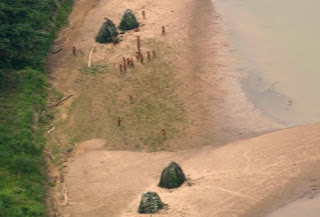
Kelly Hearn in Jose Olaya, Peru
for
National Geographic NewsMarch 21, 2008
Driving along an oil company road in
Peru's northern Amazon, Patricio Pinola Chuje looked out the window. He nodded beyond a green wall of rain forest. "I don't know if they are in this area, but I know they are farther south in other places," said Pinola, an Achuar Indian. "They come out by the rivers."
"They" refers to unseen Amazon Indian tribes said to live in voluntary isolation in the western headwaters of the Amazon in Peru and
Ecuador. Global energy prices have fueled oil and gas booms across oil-laden Amazonian lands. But supporters of native groups say the boom is a bust for remote Amazon Indians, who suffer both physically and socially when exposed to the modern world. "Isolated Indians are especially vulnerable to any contact, because they have no immunity to outsiders' diseases," said David Hill, a spokesperson for Survival International, a London-based group that defends the rights of uncontacted tribes.
Other groups add that Indians' rights to their traditional lands are increasingly being violated by development-hungry governments. Now civic groups and native organizations are pushing governments and the courts to rein in oil development. In December, a coalition of groups announced it would petition the Organization of American States to protect the Cacataibo, said to be the last uncontacted tribe in the central Peruvian rain forest.
Meanwhile, complicating an otherwise typical development clash, Peruvian officials have publicly asked: Do unseen natives really exist? "It is like the Loch Ness monster," Cecilia Quiroz, lead counsel of Peru's oil and gas leasing agency, told The Washington Post in July. "Everyone seems to have seen or heard about uncontacted peoples, but there is no evidence."
How Many "Unseen" Tribes Are There?
Guevara Sandi Chimboras, an Achuar Indian environmental monitor, wipes sweat from his cheeks in the sweltering heat of an Amazon afternoon, not far from the Ecuadorian border. After traipsing through a grassy field, using donated satellite-positioning tools to help document oil spills, he doesn't hesitate when asked about unseen tribes. "Yes they exist," he said. "I know people who have seen them. They are seen when they go to river banks to find turtle eggs."
The elusiveness of some rain forest tribes, coupled with the threat of infection posed by outsiders, makes getting an accurate census near impossible, activists say. But Survival International estimates that some 15 uncontacted tribes live in the Peruvian Amazon alone.
Spotting them is rare. But in October, a plane searching for illegal loggers managed to photograph 21 natives standing near palm shelters on the banks of the Las Piedras River in Peru's southeastern Amazon.
Days after the photos ran on international news wires, Peruvian President Alan Garcia suggested in a newspaper editorial that unseen tribes were largely a ruse used by groups opposing development. "Against petroleum, they have created the figure of the 'unconnected' wild native, which is to say, something not known but presumed," Garcia wrote in an editorial in the newspaper El Commercio. Officials with Peru's leasing agency and its Ministry of Energy and Mines declined to comment for this story.
"Is There Something Bothering You?"
Despite official doubts that uncontacted tribes exist, oil companies apparently take threats of encounters seriously. Last summer, U.S. oil firm Barrett Resources and Spain's Repsol-YPF submitted plans to Peruvian officials describing how their workers would respond during encounters with isolated tribes. (Barrett Resources was recently acquired by the international oil company Perenco). The two documents, obtained by National Geographic News, advise workers to be on the lookout for footprints, spears, arrows, and other signs of humans.
The Barrett manual advises workers that uncontacted natives might become curious about noises, helicopters, and lights, causing them to leave items that signal a desire to make contact with workers. Such items may include "vessels containing valuable seeds or plantain drinks, necklaces, baskets, snails, gourds, feathers or other objects used for exchange," the document says. Both plans prohibit workers from having any contact with natives or giving them food or other objects.
The documents order workers to treat Indians peacefully, making efforts to protect them from illnesses. If unintended contact is made, the manuals instruct guides to initiate communication with natives in local tongues. If peaceful dialogue cannot be established, according to the Repsol document, workers should attempt to make loud noises with whistles, shouts, and megaphones.
A section of the Barrett manual entitled "sequence of messages of introduction, health and peace," tells guides to say: "We are people like you; We are workers passing through; We aren't going to stay, We have women and children far from here; We have houses and farms far from here."
The document also provides a list of questions field managers should ask Indians through their guides: "Where do you come from? How many moons and suns have you traveled? … Have you seen people like us? … Is there something bothering you?"
Self-Imposed Seclusion?
Padre Ricardo Álvarez Lobo, a Dominican priest who has worked with remote tribes for five decades, said that few if any Amazonian tribes have had no contact with outsiders. More likely, he said, their ancestors had contact with rubber barons who killed or enslaved them in the early 20th century. "The ancestors came into contact with evangelicals or rubber barons and had bad experiences," he said. "So they have built up myths within the group that makes them fear outsiders."
In recent years, extremely isolated tribes in
Brazil and
Colombia have emerged from the jungle, as developers and armed insurgents came closer to their traditional territories.
In one case, the Nukak, a tribe in southern Colombia, was driven from its extreme isolation by the insurgent group FARC. (Read related story:
"Drug Wars Threaten to Wipe Out Amazon Nomads" [April 27, 2007].)
Last June, uncontacted natives made contact with Kayapo natives in central Brazil.
And in recent weeks, across the Peruvian border in Ecuador's Yasuní National Park, Taromenane tribesmen were blamed for spearing an illegal tree logger to death.
Can They Be Protected?
As development continues to encroach on tribal territories, activists are buckling down.
Native-rights groups like Peru's Racimos de Ungurahui note that in recent years fatal illnesses have beset tribes like the Nahua, Nanti, and Kirineri after they came into contact with oil workers. Racimos has threatened to sue oil companies for genocide if they enter areas where isolated groups are said to live.
Meanwhile, a native rights group based in Lima called AIDESEP is calling for the establishment and protection of government-protected parks for uncontacted natives. Last August, AIDESEP petitioned the Inter-American Commission on Human Rights to intervene to protect two tribal reserves in northern Peru. The commission is an organ of the Organization of American States that monitors and investigates human rights violations and can litigate cases before the Inter-American Court of Human Rights. The cases are still pending before the commission.
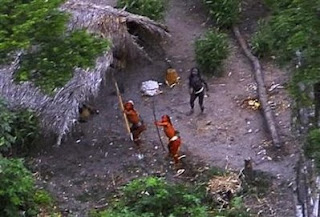 RIO DE JANEIRO (Reuters) - Amazon Indians from one of the world's last uncontacted tribes have been photographed from the air, with striking images released on Thursday showing them painted bright red and brandishing bows and arrows.
RIO DE JANEIRO (Reuters) - Amazon Indians from one of the world's last uncontacted tribes have been photographed from the air, with striking images released on Thursday showing them painted bright red and brandishing bows and arrows.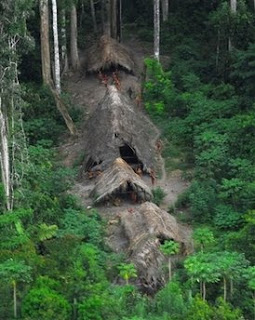 "The world needs to wake up to this, and ensure that their territory is protected in accordance with international law. Otherwise, they will soon be made extinct," said Stephen Corry, the director of Survival International, which supports tribal people around the world.
"The world needs to wake up to this, and ensure that their territory is protected in accordance with international law. Otherwise, they will soon be made extinct," said Stephen Corry, the director of Survival International, which supports tribal people around the world.
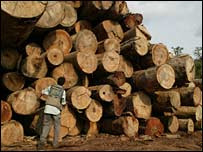
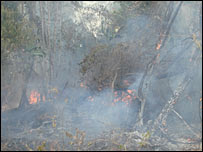
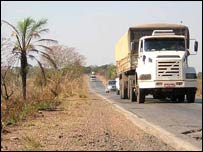 "The tools to decrease deforestation and monitor implementation of the law are still not good enough."
"The tools to decrease deforestation and monitor implementation of the law are still not good enough."

